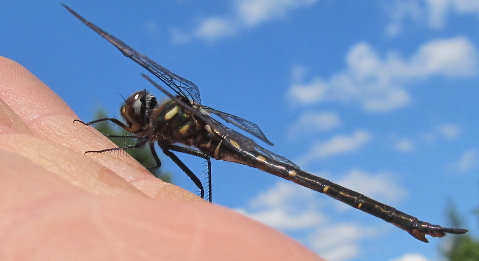Ever felt as if something was eating you up inside? Ever had a gnawing feeling in your gut that something was wrong but weren’t sure exactly what it was? Ever wish you were a dragonfly and could just fly away from it all? You might want to reconsider that wish. For some helpful perspective on life’s troubles let me introduce the abdominal ailments of Macromia illinoisensis and Didymops transversa, aka the Swift River Cruiser and Stream Cruiser.
In 2013, dragonfly experts Ken Tennessen and Bill Smith were out north of Boulder Junction, Wisconsin looking for nymphs of Somatochlora cingulata (lake emerald) when they noticed something unusual. The M. illinoisensis nymphs they collected had something long and white coiled inside their abdomens. Although both Ken and Bill each had decades of experience collecting cruiser nymphs in Wisconsin and elsewhere, they had never seen anything like this before.

What Ken and Bill observed: Macromia nymph with ropy white coils inside. Photo © Dr. Ken Tennessen
They dissected some of the nymphs and confirmed their suspicions. The nymphs were being parasitized by some sort of nematode (round worm). Nematode parasites of dragonflies had rarely been reported before, and the two went on to confirm that the closely related Didymops transversa is also being parasitized in some Wisconsin lakes. The culprit is apparently a nematode in the family Mermithidae, and it does not seem to be hosted by any other type of dragonfly in the area. It may prove to be specific to the Macromiidae.

Macromia illinoisensis nymph dissected to show the nematodes within. Photo © Dennis Johnson
Mermethidae are a taxonomically difficult and poorly known group, as are most nematodes. They are somewhat infamous though because of Mermis nigrescens, a mermithid that parasitizes grasshoppers. That species lays its eggs on vegetation, and the grasshopper ingests the eggs which hatch and grow to great lengths internally. The parasite can grow to at least 6 inches in the body cavity, feeding on the hemolymph (blood) of the grasshopper. They then exit the body of the unfortunate dead..or living…grasshopper, and complete their life cycle in the soil.
This find opens an exciting new area of discovery in regional dragonfly biology, and is just one of several major dragonfly discoveries that Ken and Bill have been involved in. Their research team now includes Marla Garrison and Dennis Johnson, and I expect more interesting news from this group in the future.
Tennessen, K., W.A. Smith, M. Garrison and D. johnson. 2015. Nematode Parasites in Nymphs of Macromia illinoiensis in Northern Wisconsin Lakes. Argia: 27 (1) p. 24-25.
©2017 Wayne P. Steffens
